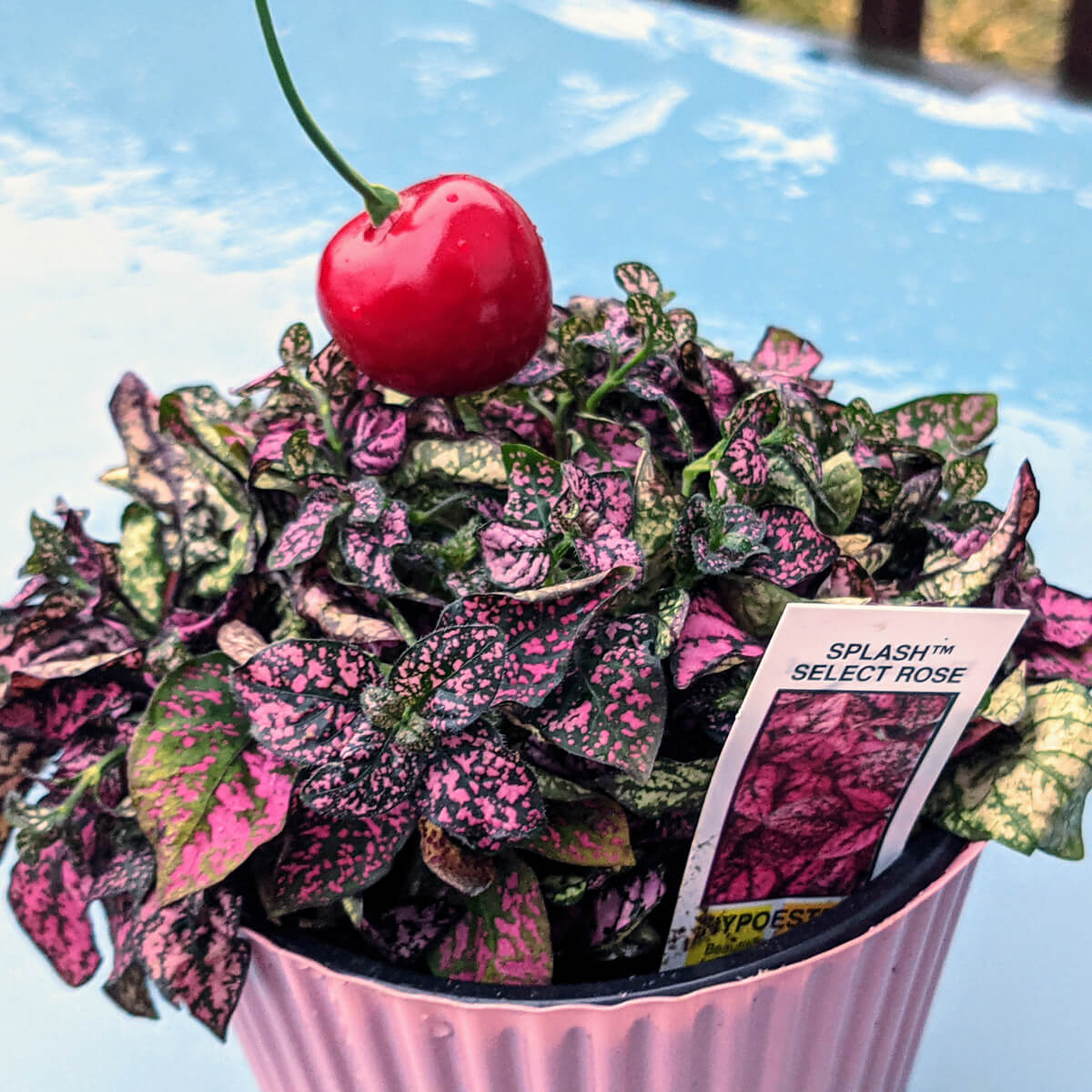Polka Dot Plant – Hypoestes Care, Water & Light
Polka dot plant (Hypoestes phyllostachya or Hypoestes sanguinolenta) can grow indoors or outdoors, depending on the time of year and climate. Learn about polka dot plant care to discover its light requirements, watering needs, and best soil type.
Knowing about hypoestes care gives you an edge in keeping your polka dot plant alive.
This plant was new to me and I bought it purely because my 6-year-old begged for the “cupcake plant,” which she later named “plantcake.”

Our first run with the “Freckle Face” plant didn’t go so well, so I’ve taken it upon myself to learn all I can about polka dot plant care so we can do a better job next time.
Hopefully I can save you the loss of a hypoestes plant, too. Let’s discover how to care for polka dot plant together.
What is the polka dot plant?
The scientific name of the polka dot plant is hypoestes phyllostachya. It’s also sometimes called “Freckle Face plant.” This plant belongs in the Acanthaceae family of dicotyledonous flowering plants, which includes mainly tropical herbs, vines, and shrubs. The variegated leaves feature dots of white or pink amid green splotches that eventually run together in most cases.
Polka dot plant is considered an evergreen shrub, but it is generally grown as an ornamental or a houseplant. Bear in mind this pretty plant is only winter hardy as an herbaceous perennial in growing zones 10 – 11, so it is usually treated as an annual in other regions.
Hypoestes Care Tips
Hypoestes phyllostachya care breaks down into a few main categories:
- Light Requirements – bright, indirect sunlight
- Watering Needs – consistently moist but not soaked
- Soil Type – light, well-draining, acidic
- Pruning – prune to reduce height as needed
Keep reading to learn how to care for hypoestes polka dot plant.

Polka Dot Plant Soil Needs
The polka dot plant’s soil needs tend to be rich in organic material and freely draining. Cactus and succulent potting mix or even typical potting soil should be fine for hypoestes plants. Consider mixing in 50% perlite for better drainage if needed.
Hypoestes phyllostachya soil requirements lean toward an acidic soil pH of 5.6 to 6.5. (You can check out other acid-loving plants!)
Polka Dot Plant Light Requirements
When polka dot plant sunlight needs are met, this pretty plant can thrive. Aim for a moderate to bright spot in your home if growing polka dot indoors. Bright, indirect sunlight is usually best.
If growing polka dot plant outdoors, choose a spot in the garden where the plant will enjoy a little shade, too. The delicate leaves can tolerate some direct sun but may be easily damaged if sunlight is too harsh for too long.
The plant may tolerate lower light conditions for a period of time if necessary. However, don’t be surprised if you see the plant’s form change to a leggier, lankier version of itself.
If you notice you’ve got a leggy polka dot plant, this generally means your hypoestes is not getting enough sunlight. Move it to a sunnier space or near some LED grow lights to for more effective polka dot plant care.
Polka Dot Plant Watering Needs
The polka dot plant watering requirements call for soil that remains moist. Avoid soggy soil and also avoid letting the soil dry out too much.
If the soil does dry out, your polka dot plant may wilt. Watering it in time can bring it back. If left too long, freckle face plant may unfortunately die.
What’s wrong with my polka dot plant?
Problems may arise when the polka dot plant care process goes differently than the plant’s ideal requirements. Some common things that can go wrong with polka dot plant are: too little water, too much water, and too little light. Your hypoestes may also suffer from root rot, pests, and other ailments.

When you buy or receive a polka dot plant, make sure you provide proper care for light, water, and soil type.
Signs of problems in a polka dot plant:
- Wilting
- Browning
- Yellowing
- Crispy Leaves
- Curling Leaves
- Leggy and Growing Tall but Spindly
- Color Changes / Color Loss
Polka Dot Plant Crispy Leaves
The polka dot plant’s leaves may become crispy if the plant is underwatered. This may also happen if the humidity is too low for the plant.
My best advice on the hypoestes is don’t do what we did. Polka dot plant watering ended up being the death of us. Our plant went out of sight for a week or more, and we forgot to water it.
The hypoestes leaves were still soft but a bit crunchy on the edges, so I thought we could save it.
My daughter and I watered the plant, but I think it then went into shock. A few days later when we checked on it, the entire plant was crispy and dry. Perhaps it didn’t have the right soil. Maybe it wasn’t entirely our fault. Let’s go with that!
Caring for Freckle Face Plant
After a particularly disappointing first run, we will look forward to caring for freckle face plant another time. Honestly, my youngest daughter is just so happy we still have the cupcake plant wrapper to use for a new plant.

Once I get a better handle on houseplants and tender perennial ornamentals, I’ll give it another go. In the meantime, please shout at us with any of your own experiences growing polka dot freckle face plant.
If you have any additional tips on hypoestes phyllostachya, please share them in the comments below! You can also feel free to ask questions and we’ll do our best to help.
Happy Gardening!






